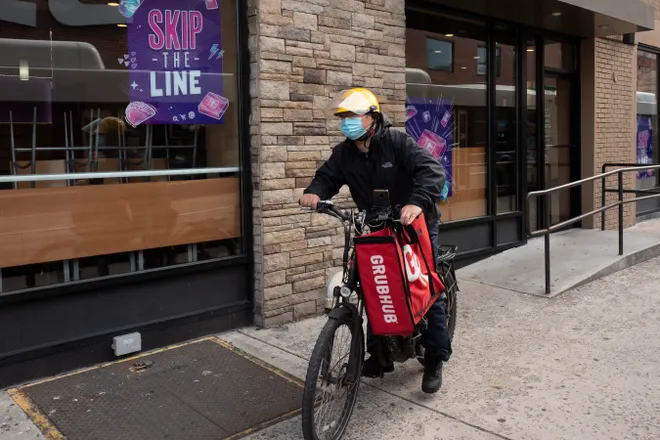Ever heard of ghost kitchens? These virtual restaurants are changing the delivery industry
The popularity of food delivery services skyrocketed during the COVID-19 pandemic. Bloomberg Second Measure reports that combined sales for meal delivery services grew 162% in April 2020 compared to the previous year. Since then, sales have grown 5% every year.
The growth in popularity of these apps during the pandemic also grew the number of ghost kitchens, some even taking the likeness of celebrities. George Lopez Tacos, Buddy V’s Cake Slice by Buddy Valastro, Guy Fieri’s Flavortown Kitchen and HotBox by Wiz Khalifa are just a few of the many ghost kitchens on the market.
Popular YouTuber James Donaldson, also known as MrBeast, launched his ghost kitchen brand MrBeast Burger in December 2020 but in mid-June 2023 announced that he would be moving on from the virtual brand. In early August, Donaldson sued his ghost kitchen partner, Virtual Dining Concepts, over “inedible” food resulting in negative reviews that harmed his reputation.
What exactly is a ghost kitchen? Dig into the reality of ghost kitchens and how they work.
How much does online food delivery pay?DoorDash and Uber Eats compensation.
What is a ghost kitchen?
A ghost kitchen, also known as a dark kitchen or cloud kitchen, is a digital-only restaurant that is available only on food delivery apps like Postmates, UberEats and GrubHub. These kitchens only offer food items and drinks from online brands, cutting out the storefront and human interaction of traditional eateries.
In other words, cooks from existing restaurants or kitchen-only spaces prepare food items marketed from another brand that is exclusively sold through third-party, food delivery apps.

How do ghost kitchens work?
Food from these kitchens can only be received through delivery services, which means that customers will not be able to visit a store-front in person.
However, the physical kitchen does exist in order to make the products. Most commonly, ghost kitchen companies may operate out of existing chain or independent restaurants that want to make extra revenue. Ghost kitchen brands can partner with hundreds of established kitchens across the United States to produce and distribute their products. In exchange, the partners get a small cut of the profit made from the delivery.
MrBeast Burger is one example. Donaldson’s brand opened 300 locations around the United States in its first week. None of the 300 locations were branded as MrBeast Burger restaurants but rather 300 locations where MrBeast Burger food is produced. The burgers and fries were cooked in commercial kitchens of chain restaurants such as Buca di Beppo and Bertucci’s, Restaurant Business Magazine reports.
On the third-party delivery apps that offer food from ghost kitchens, it will not list the restaurant where the food is made. The ghost kitchen brand is listed so customers can order from the exclusive menu from the digital brand.
Is Uber safe?Addressing safety concerns of passengers and drivers.
How to start a ghost kitchen
These digital-only restaurants are started by small business owners, entrepreneurs, established chains and influences for different reasons. Some use ghost kitchens as a cheaper means of starting their own restaurant, while others make ghost kitchens to create extra revenue for their existing business, BMarko Structures reports.
According to BMarko Structures, the median construction cost to start a traditional restaurant is around $200,000. With a ghost kitchen, that price is cut by around 50-60%. Some may consider renting or purchasing a shipping container kitchen with appliances installed to be the main house of operations for the ghost kitchen.
Toast, one of the leading POS (point of sale) systems in the United States, outlines the basic necessities to start a ghost kitchen after deciding the concept, hypothetical menu and business model.
Starting to obtain the same licenses and permits asked of restaurants traditional restaurants is the first important step. Here is a list of some the documents likely required to operate as a food service:
- Business License
- Food Service License
- Employee health Permit
- Seller’s Permit
- Zoning Permit
After these documents are obtained, you may consider where you want to produce and distribute the food. Here are some kitchen options that Toast outlines as popular spaces for ghost kitchen operations:
- Shared kitchens: a licensed and inspected commercial kitchen that is available for rent by the hour, day, week or month.
- Dark kitchens: kitchen-only spaces that do not accommodate dine-in customers and focus only on preparing delivery-only food.
If you are looking for more guidance on how to start your own ghost kitchen, you may consider partnering with a ghost kitchen management company. Some of the most successful names in the ghost kitchen game are partnered with Virtual Dining Concepts, CloudKitchens, Nextbite and Ghost Kitchen Brands.
Just Curious for more?
USA TODAY is exploring the questions you and others ask every day. From "Where does salt come from?" to "How to get rid of fruit flies" to "How much water should you drink?", we're striving to find answers to the most common questions you ask every day. Head to our Just Curious section to see what else we can answer.
Disclaimer: The copyright of this article belongs to the original author. Reposting this article is solely for the purpose of information dissemination and does not constitute any investment advice. If there is any infringement, please contact us immediately. We will make corrections or deletions as necessary. Thank you.







